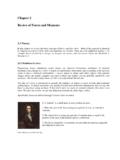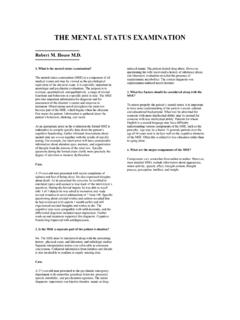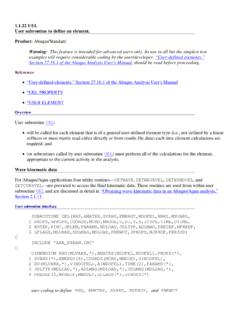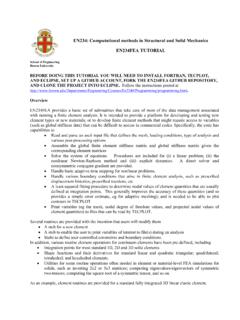Transcription of 35. Introduction to nonlinear optics - Brown University
1 35. Introduction to nonlinear opticsWhat are nonlinear -optical effects and why do they occur?Maxwell's equations in a mediumNonlinear-optical mediaSecond-harmonic generationConservation laws for photons ("Phase-matching") nonlinear optics can produce many exotic effectsSending infrared light into a crystal yielded this display of green light: nonlinear optics allows us to change the color of a light beam, to change its shape in space and time, and to create the shortest events ever made by optical phenomena are the basis of many components of optical communications systems, optical sensing, and materials do nonlinear -optical effects occur?
2 Recall that, in normal linear optics , a light wave acts on a molecule, which vibrates and then emits its own light wave that interferes with the original light can also imagine thisprocess in terms of the molecular energy levels,using arrows for thephoton energies:Why do nonlinear -optical effects occur? (continued)Now, suppose the irradiance is high enough that many molecules are excited to the higher-energy state. This state can then act as the lower level for additional excitation. This yields vibrations at all frequencies corresponding to all energy differences between populated picture is a little bit misleading because it suggests that the intermediate energy level is necessary, which isn t this particular model, this is.
3 Reminder: Maxwell's Equations in a MediumThe induced polarization, P, contains the effect of the medium. The inhomogeneouswave equation (in one dimension):2220222201 EEPxtdtc 0PE The polarization is usually proportional to the electric field: = unitless proportionality constantcalled the susceptibility Then, the wave equation becomes: 22200222201 EEExctdt 22222010 EExtc or00201 c sinceRecall, for example, in the forced oscillator model, we found: 20000/()2eNemPtE tj But this only worked because P was proportional to : Maxwell's Equations in a Medium 22222010 EExtc And, we call the quantity the refractive index.
4 1 So, we can describe light in a medium just like light in vacuum, as long as we take into account the (possibly complex) refractive index correction to the if it isn t? Then P is a non-linearfunction of E! 22011 cc Of course this is the same equation as the usual homogeneousequation (waves in empty space), as long as we define:Maxwell's Equations in a NonlinearMediumNonlinear optics is what happens when the polarization includeshigher-order ( nonlinear !) terms in the electric field:(1)( 2 )2( 3) Linearnon linearPEEEPP Then the wave equation looks like this:222202222 non linearPEn Exctdt The linear term can be treated in the same way as before, givingrise to the refractive index.
5 But the non-linear term is a 22222(2)2(3)3000022222 En EEExctdtdt Usually, (2), (3), etc., are very small and can be ignored. But not if Eis instead of just one proportionality constant , we have a family of them: (1), (2), (3), etc.*00( )exp()exp() EtEjtEjt What sort of effect does this non-linear term have?terms that vary at a new frequency, the 2nd harmonic, 2 !The effects of the non-linear termsIf we write the field as:222*2000( )exp(2) 2exp( 2) EtEjtEEjt thenNonlinearity can lead to the generation of new frequency can be extremely useful:Frequency doubling crystal:1064 nm 532 nmThe birth of nonlinear opticsIn 1961, P.
6 Franken et a pulsed ruby laser ( = 694 nm) into a quartz crystal. With about 3 joules of energy in the red pulse, they generated a few nanojoules of blue light ( = 347 nm)from Phys. Rev. Lett., 7, 118 (1961)The copy editor thought it was a speck of dirt, and removed and difference frequency generation **11112222( )exp()exp()exp()exp() EtEjtEjtEjtEjt 22*211112*22222**12121212**121212122212( )exp(2)exp( 2) exp(2)exp( 2) 2exp() 2exp() 2exp() 2exp() 22 EtEj t Ej tEjtE jtEEjtEEjtEEjtEEjtEE Suppose there are two different-color beams present, not just one:Then E(t)2has 16 terms.
7 2nd harmonic of 12nd harmonic of 2sum frequencydifference frequencyzero frequency - known as optical rectification This is an awful lot of processes - do they all occur simultaneously? Which one dominates (if any)? What determines the efficiency?Complicated nonlinear -optical effects can more photons ( , the higher the order) the weaker the effect, however. Very-high-order effects can be seen, but they require very high irradiance, since usually (2)> (3)> (4)> (5).. nonlinear -optical processesare often referred to as:"N-wave-mixing processes"where N is the number ofphotons involved (including the emitted one).
8 Frequency doubling is a three-wave mixing energyThis cartoon illustrates a 6-wave mixing process. It would involve the (5)term in the wave laws for photons in nonlinear optics12345 0 12345 0 kk kk k k0 kUnfortunately, may not correspond to a light wave at frequency 0!Satisfying these two relations simultaneously is called "phase-matching."Energy must be conserved. Recall that the energy of a photon is . Thus: Photon momentum must also be conserved. The momentum of a photon is , so: kNo more than one of the many possible N-wave mixing processes can be phase-matched at any one time.
9 Most of the time, none of them : an exampleConsider the 2nd harmonic generation process: nonlinear material in outEnergy conservation requires: 22nn nccc Momentum conservation requires: 2 kk k 2 red photons1 blue photon(2 )( )nn Unfortunately, dispersion prevents this from ever happening! 2 FrequencyRefractive indexFrequencyRefractive indexonenPhase-matching second -Harmonic generation using birefringence(2 )( )oenn Birefringent materials have different refractive indices for different polarizations: the Ordinary and Extraordinary refractive indices!Using this, we can satisfy the phase-matching condition.
10 2 For example:Use the extraordinary polarizationfor and the ordinary for 2 :nedepends on propagation angle, so by rotating the birefringent crystal, we can tune the condition precisely by moving the red curve up and down relative to the blue created in real crystalsFar from phase-matching:Note that SH beam is brighter as phase-matching is to phase-matching:Input beamSHG crystalStrong output beamInput beamSHG crystalweak output beamSecond-Harmonic GenerationSHG crystals at Lawrence Livermore National LaboratoryThese crystals convert as much as 80% of the input light to its second harmonic. Then additional crystals produce the third harmonic with similar efficiency!









